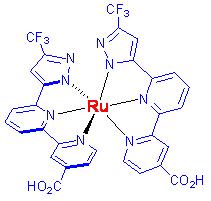|
New breakthrough in Solar Power Cells - Dye Sensitized Solar Power Cell The research team led by Professor Chou has already achieved some measurable results in developing Renewable Energy. A representative product should be ascribed to the Dye Sensitized Solar Power Cell. Dye Sensitized Solar Power Cells are the most competitive solar power cells since the traditional Silicon-based semiconductor solar power cells were developed. The new product possesses advantages such as ease of manufacturing, low price, and, when used in junction with certain solid state conductors, great plasticity and portability. In the development of futuristic technologies such as electronic newspaper and super-thin devices, these advantages cannot be replaced by traditional silicon-based Solar Cells.
Using ruthenium complexes as a dye, the operating principles for dye sensitized solar cells are as follows: first of all, ruthenium complexes with carboxylic functional groups can be efficiently combined with nano-sized TIO2 to form covalent chemical bonding. In principle, the Ru complexes are desinged to absorb the visible part of sunlight, and when it does that, the electron immediately jumps to a so-called "electronically excited state," resulting in a loss of one electron in its ground state, a phenomenon commonly referred to as the "hole." The excited electron quickly moves to the conduction band of TIO2. If the electron reaches the cathode through outer circuits before it recombines with the hole, and again through the electrolytes combines with the hole formed in the dye by inner circuits, the whole system will form a revolving circuit, the result of which allows the electrons in the outer circuits to produce electrical current, establishing a prototypical solar cell.
The ideal solar power cell described above, however, leaves a lot to be desired. The main obstacle lies in that the electrons and the hole can be combined at any juncture, generating heat that can not be utilized and resulting in the lowering of the total conversion efficiency and waste of energy.
Due to these reasons, although researches on solar powered cells have mushroomed in great numbers since 1991, the corresponding breakthroughs in manufacturing have been disproportionately sparse and slow.
|
|
To correct the shortcomings, the research team led by Professor Chou boldly invested visionary research into Renewable Energy and designed and synthesized a series of new ruthnium derivatives and nanomaterials. Based on different material properties, the NTU team has already surpassed the old limitations of Solar Power Cells by developing inorganic complex types of photo-sensitive power cells as well as Solar Power Cells based on semiconducting nanomaterials.
Experimental results show that the new generation complex-1 type Solar Power Cell can achieve an energy conversion efficiency as high as 6.0%. Moreover, the compex-1 sensitized solar power cells can be thinner and more stable, also more efficient in elctron and hole separation, worthy of further development.
|
International exchange student participants at the UMAP Biannual International Conference make posters together. Such diversified activity contents serve to enhance the student participants' international outlook and recognition of each member country's cultural identity.
|
|
Additionally, the NTU research team used semiconducting nanomaterial as a base and created photo-sensitive Solar Power Cells. The newly developed material "NANO-1" can be used to increase the transmission efficiency of electrons in Solar Power Cell. This type of hybrid nanotech material that combined semiconductors and organic materials will possess a high degree of applicability in future research in the field of Renewable Energy.
With the aid of funding from the Elite University Strategic Plan, Professor Chou's research group will establish production and testing facilities to raise the team's research quality and enable NTU to attain the highest international standards in the field of Renewable Energy. |



